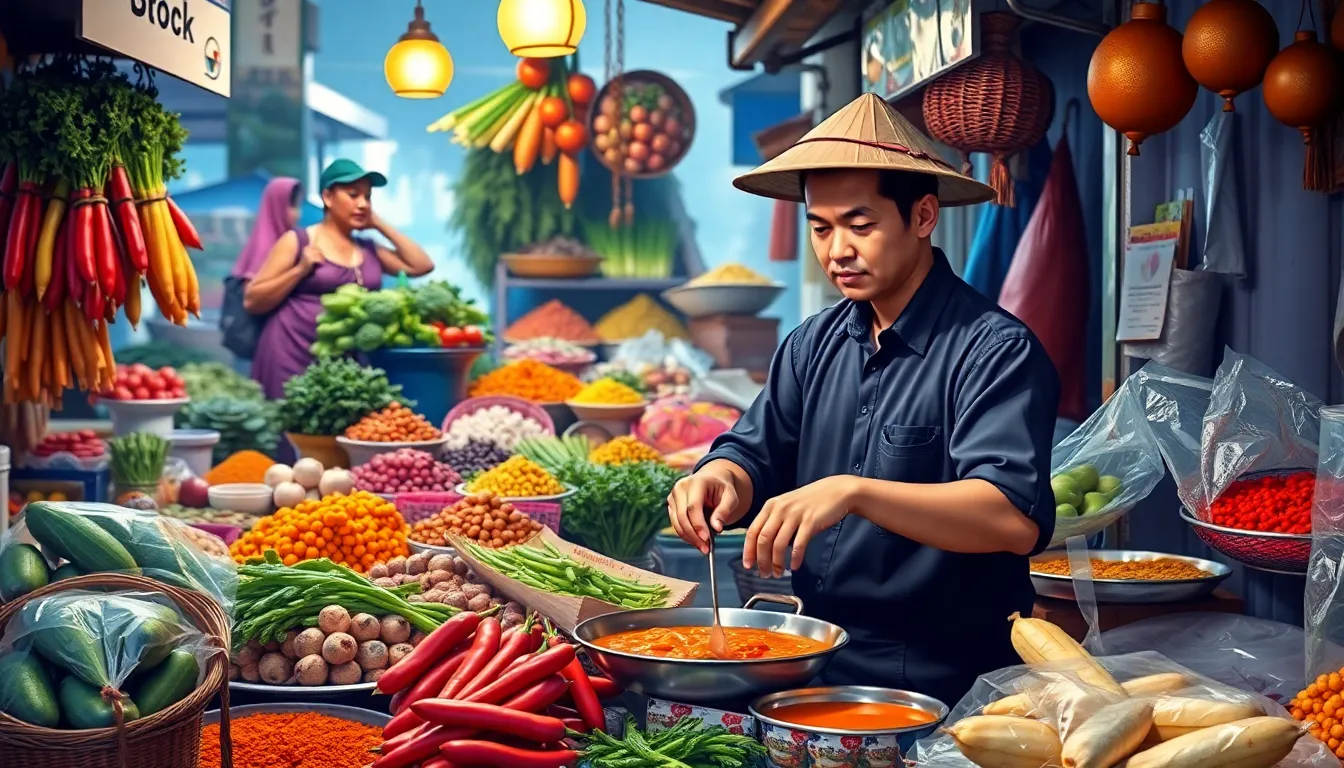Traveling the world through food is one of life’s greatest pleasures. Imagine savoring spicy Thai curry one moment and indulging in rich Italian pasta the next. International cuisine offers a delicious passport to diverse cultures, turning every meal into an adventure.
Table of Contents
ToggleOverview of International Cuisine
International cuisine encompasses diverse culinary traditions from around the globe. Each culture offers unique flavors, cooking techniques, and ingredients. For instance, Asian cuisine often features rice and noodles as staples, while Mediterranean dishes emphasize fresh vegetables and olive oil.
Regional variations add depth to international cuisine. French gastronomy showcases sauces and pastries, while Mexican cuisine highlights bold spices and vibrant ingredients. Many countries celebrate their culinary heritage during festivals, allowing visitors to explore authentic dishes.
Popular international dishes attract food enthusiasts. Sushi, originating from Japan, includes vinegared rice paired with seafood or vegetables. Indian curries incorporate rich spices, creating complex flavor profiles that appeal to many. Italian pizza emphasizes simplicity with quality ingredients like tomatoes and mozzarella.
Culinary fusion reflects the blend of different cultural influences. Chefs create innovative dishes that combine techniques and flavors. Examples include Korean tacos, which merge traditional Korean fillings with a Mexican tortilla.
Exploring international cuisine opens opportunities for cultural exchange. Shared meals foster understanding and appreciation among diverse communities. Street food markets in cities worldwide offer a glimpse into local flavors, enhancing the overall dining experience.
Traveling presents chances to taste authentic dishes in their countries of origin. Sampling local cuisine can deepen one’s connection to a culture. As people embark on culinary adventures, they embrace the global tapestry of flavors that international cuisine has to offer.
Regional Cuisines

Exploring regional cuisines reveals unique culinary identities and traditions from around the world. Each region offers special flavors that reflect its cultural heritage.
Asian Cuisine
Asian cuisine encompasses a variety of flavors and cooking techniques. Countries like Thailand and India stand out with their bold dishes. Thai curry, rich in spices and coconut milk, excites the palate. On the other hand, Indian curries showcase complex spice blends, creating a rich, aromatic experience. Sushi, originating from Japan, combines fresh seafood with vinegared rice, presenting a delicate balance of taste and texture. Street food in Asia offers additional layers of culinary adventures, whether it’s satay in Indonesia or dim sum in China.
European Cuisine
European cuisine showcases diverse cooking styles and regional ingredients. Each country contributes distinct dishes. Italian pasta exemplifies simplicity in taste, highlighting fresh ingredients like tomatoes and basil. French gastronomy emphasizes technique, offering exquisite sauces and pastries. Greek food celebrates freshness with dishes like moussaka and tzatziki, beautifully combining flavors of the Mediterranean. German cuisine features hearty foods such as bratwurst and sauerkraut, reflecting its cultural roots. A visit to each European country unveils a rich tapestry of flavors and culinary traditions.
African Cuisine
African cuisine is characterized by its robust flavors and communal dining practices. North African tagines present a range of spices with slow-cooked meats and vegetables. West African jollof rice, often prepared for celebrations, combines rice with tomatoes and spices, showcasing regional variations. East African dishes like injera and doro wat highlight the influence of local ingredients and cultural exchanges. South African braai culture celebrates grilled meats, bringing communities together over shared meals. Each African region offers an array of dishes that narrate its history and culture.
Popular Dishes Around the World
Exploring international cuisine reveals a vast array of popular dishes that delight food lovers everywhere. These culinary treasures connect cultures and showcase the flavors defining their regions.
Street Food Delights
Street food offers a unique glimpse into regional flavors. In Thailand, vendors serve pad thai, stir-fried rice noodles topped with peanuts and lime. Tacos in Mexico highlight vibrant fillings and salsas, grabbed quickly by locals and tourists alike. India’s chaat combines sweet and savory with crispy chickpea flour dumplings. Around the globe, street food serves not just as a meal but as a cultural experience. Markets bustling with activity feature items like Vietnamese banh mi and Taiwanese bubble tea, providing authentic tastes that reflect local life.
Signature Dishes
Culinary signatures define each region’s heritage and taste. Italy’s risotto showcases creamy rice cooked slowly in broth, often flavored with saffron. Spain’s paella features saffron-infused rice mixed with seafood or meats, cooked in a distinctive pan. Argentine asado celebrates grilling meats in a social atmosphere, creating a communal dining experience. These signature dishes tell stories of cultural identity and local ingredients. France’s coq au vin represents rich flavors, simmered in wine for tender chicken. Across continents, each signature dish embodies a connection to its cultural roots.
Cultural Significance of International Cuisine
International cuisine serves as a vital link between people and their cultural identities. Each dish tells a story, reflecting historical influences and local practices. For instance, many culinary traditions emphasize communal dining, promoting social interactions and relationships among families and friends.
Food festivals around the world celebrate regional specialties, showcasing traditional recipes passed down through generations. These festivals not only highlight flavors but also allow communities to preserve and share their heritage. Unique culinary practices often emerge from geographical and historical contexts, deepening appreciation for the ingredients and techniques specific to each area.
Culinary fusion has gained popularity, blending attributes from different cultures. Korean tacos illustrate this trend, combining traditional Korean marinated meats with Mexican tortillas. This blend creates new experiences while demonstrating the adaptability of cultural cuisines. Individuals exploring international dishes often develop a keen understanding of diverse perspectives and lifestyles.
Street food plays a significant role in cultural expression. Common dishes like Thai pad thai, Mexican tacos, and Indian chaat encapsulate local flavors and customs. These offerings provide street-level insights into cultural practices, bringing people together under the shared experience of enjoying flavorful food.
International cuisine fosters connections across borders and enhances cultural exchange. Every meal carries significance through its ingredients, preparation, and presentation, making food an essential element of communal identity. Engaging with various culinary traditions allows individuals to embrace and celebrate the global tapestry of flavors that enrich their lives.
Exploring international cuisine opens a world of flavors and traditions that enriches the dining experience. Each dish serves as a bridge connecting cultures and fostering understanding among people. The vibrant tapestry of global culinary practices not only tantalizes taste buds but also tells stories of history and heritage.
As individuals indulge in diverse meals from street food to gourmet dishes they embrace the essence of different cultures. This culinary journey promotes appreciation for the artistry behind each recipe while encouraging a sense of community. Ultimately, international cuisine is a celebration of life’s flavors that unites us all in our shared love for food.



